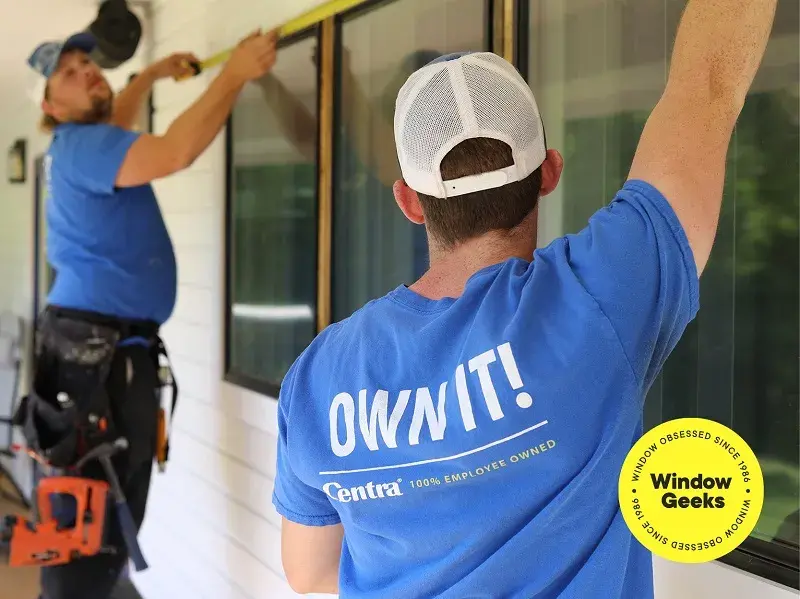Windows
How to Know Whether it is a Window Leak or Condensation
Geek Level 1
If you've started noticing water on or around your windows, the first thing to do is to identify whether it’s a leak or condensation. While condensation is common and typically harmless, a leak may indicate a more serious issue. In this guide, Centra Install Pros will help you figure out the cause of water on your windows and what actions, if any, you need to take.
Step-by-Step Instructions: How to Know Whether it’s a Leak or Condensation
Check the Location of the Water
The location of the water can often tell you whether it's condensation or a leak.
- Condensation: If the water is beading on or fogging up the glass pane, it is almost certainly condensation.
- Leak: If the water is on the seal or window frame rather than the glass itself, then it could be a leak, especially if the water is coming in from the top.
Identify Where the Condensation is Located
Condensation can form on either the inside or outside of the window. Each scenario has different causes:
- Outside condensation: If the condensation is on the outside of the window, it’s likely due to the weather. This can happen if it’s cold outside, as the heat inside your home keeps the inside of the window warm, while the outside pane remains cold, leading to condensation.
- Inside condensation: Condensation inside the window is typically caused by indoor humidity. Cooking, showering, or using hot water may raise the humidity levels in your home, leading to condensation on windows and mirrors. The condensation itself is everywhere – these are just the easiest places to see it. This can be fixed by improving ventilation, such as opening a window or using an extractor fan. Make sure to do this regularly to prevent mould or mildew growth.
Pro Tip: Try drawing a smiley face on the window with your finger. If you can, you know the condensation is inside the home.
Check for Condensation Between the Panes
Unlike regular cases, condensation between the window’s panes is a cause for concern.
- Why it’s a problem: The space between the panes is supposed to be airtight. If you notice condensation between the panes, it means the seal has failed, allowing moisture to enter.
- Next steps: Unfortunately, there’s not much you can do besides contacting a professional for service. In most cases, the affected window will need to be replaced.
Inspect Your Windows Regularly
Regular window inspections are essential to catch problems early.
- Inspect for damage: Check for any visible issues such as cracks in the seal, condensation between the panes, or water staining around the frame.
- Don’t delay: Addressing minor issues promptly can save you from bigger, costlier repairs down the road.
Why Identifying the Cause is Important
Understanding whether the issue is condensation or a leak is crucial to keeping your windows in good condition:
- Condensation: If it's condensation, it’s typically an issue related to humidity or weather, and it’s easy to resolve by improving ventilation or making sure the window's insulation is working as it should.
- Leak: If it’s a leak, it could indicate that your window or seal is damaged, leading to potential water damage or energy loss. In this case, action should be taken quickly to prevent further issues, like mould or higher energy bills.
Common Issues with Window Leaks and Condensation
Here are some common problems homeowners encounter with window leaks and condensation, and tips on how to address them:
- Condensation on the inside: If you notice persistent condensation inside the window, it could be due to high humidity levels in your home. Make sure your home is well-ventilated by using fans, opening windows, or using a dehumidifier.
- Leaks around the frame: Leaks can occur around the window frame if the seal has broken or the window was not properly installed. Check the sealant and weatherstripping and replace them if necessary.
- Condensation between panes: This is a sign that the seal is broken and the window may need to be replaced. If this is the case, contact a professional for window servicing.
Pro Tips for Maintaining Window Seals and Preventing Condensation
- Check for proper seals: Make sure your window seals and weatherstripping are intact to prevent water infiltration and poor window performance in terms of energy efficiency.
- Control indoor humidity: Keep indoor humidity levels in check by using ventilation or a dehumidifier, especially in areas like bathrooms and kitchens where humidity levels tend to rise.
- Regular inspections: Inspect your windows regularly to catch any issues early. This can help you prevent leaks and ensure your windows are functioning optimally.
- Choose quality windows: Centra manufactures energy-efficient vinyl and hybrid windows crafted to the highest standards. Our custom-made products are tailored for your specific project and come with an unrivalled 30-year warranty. Designed with the end-user in mind, they are built to minimize maintenance needs.
FAQ: Window Leaks & Condensation
How do I know if my window is leaking?
If you notice water around the window frame or coming from the top of the window, it’s likely a leak. Condensation typically forms on the glass itself.
What causes condensation between window panes?
Condensation between panes occurs when the seal on the window is broken, allowing moisture to enter the space between the panes. This requires professional repair or window replacement.
How can I prevent condensation on windows?
Ensure proper ventilation in your home, especially in areas with high humidity, such as the kitchen and bathroom. Using exhaust fans or opening windows can help reduce indoor humidity levels.
Centra: Western Canada’s Top Choice for Windows & Doors
Have an upcoming window and door project? Reach out to the experts for a free consultation! If you have any questions regarding this topic or anything else to do with windows, contact a local Centra Employee Owner at 1-888-534-3333 or drop us an email at info@centra.ca. Follow us on Facebook and Instagram to stay up to date, and test your window knowledge on LinkedIn.
Recommended for you

Geek Level 1
Windows
How to Fix a Window Leak at Home
Geek Level 1
Windows
How to Inspect Window Weatherstripping



